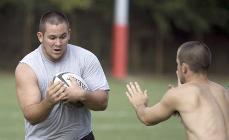It’s a typical Tuesday night on N.C. State’s Lower Miller Fields. Joggers run laps. Footballs zoom through the air in every direction, and a group of about 30 young men huddle together and hold hands.
They are athletes — members of the Wolfpack men’s rugby club team — and they are doing the scrum.
According to veteran player Nathan Carpenter, the scrum is a formation used when a play needs to be restarted due to an infringement.
“The famous rugby move that everyone remembers is called the scrum,” Carpenter, a senior in philosophy, said. “Players will combine together, and it actually becomes a big shoving match once the ball goes into the scrum.”
State’s rugby players can also be distinguished from other students using the field due to their practice attire. The “short shorts” — as the players refer to them — they wear are reminiscent of old-school NBA attire.
Andrew Reagan, a sophomore in business management, better known as “Sauce” by his teammates, said the shorts serve a practical purpose.
“Well, besides the beauty of them, they also help us play the game and keep our legs cool,” Reagan said.
Wardrobe oddities and wacky formations aside, club rugby has recently been one of the school’s most successful teams at any level — varsity or club.
The team competes annually at the North Carolina State Cup, which is the championship for all college rugby teams in the state of North Carolina. In the past seven years alone, the team has finished runner-up four times and claimed the title three times — the most recent win was last season.
According to coach Jeremy Goodwin, the program’s success is a direct reflection of the team’s dedication.
“These guys work hard on their own. They are all self-motivated to be out here,” Goodwin said. “Nobody is getting money. There are no scholarships. They come out here and dedicate their time to play a sport that is very well-recognized around the world.”
Rugby is a sport that is well-known in “most areas that don’t play American football,” according to sidelined player Larry Whysall, a junior in mechanical engineering. It is popular in countries like Australia, South Africa and New Zealand — where Whysall was injured while playing this summer.
Tyler Morrison, a sophomore in architecture, said rugby appeals to a wide range of individuals.
“The best thing about rugby is that it is good for all ages and sizes,” Morrison said. “[Players range] from tall to short, big to skinny, fast to slow.”
Club president Kyle Hojnacki referred to rugby as “an interesting sport unlike any other we have in the States,” while Carpenter explained rugby as a mix of two popular U.S. pastimes.
“Rugby is a combination of soccer and football,” Carpenter said. “You have your hitting of football minus the pads. It is a continuous game like soccer, and in that way, it is also exhausting because you are only allowed seven substitutions the entire game.”
The team practices two days a week for two hours at a time to prepare for matches on Saturdays. The program emphasizes a high level of cardiovascular fitness, as the team runs “pretty much the entire practice,” Carpenter said.
Drew Lynch, a freshman in political science, said he has played rugby since he was 11 years old, but he said practices are tougher than he anticipated at this point.
“The intensity level of practices for this early in the season is very high,” Lynch said.
In addition to intense practicing, members must pay dues, take valuable time away from their studies and condition in triple-digit temperatures, yet they consistently show up to practice ready to play.
According to Hojnacki, a senior in aerospace engineering, it’s all for the love of the game.
“I think you have to love rugby to come out and play it, because we’re all just a little bit insane,” Hojnacki said.








